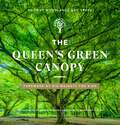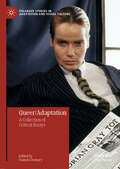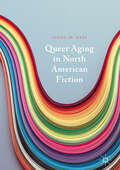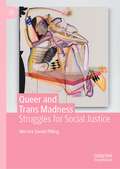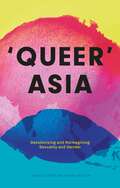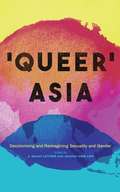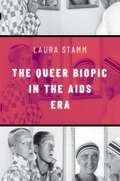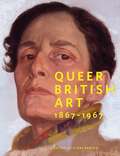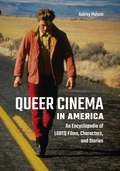- Table View
- List View
The Queen's Embroiderer: A True Story of Paris, Lovers, Swindlers, and the First Stock Market Crisis
by Joan DeJeanFrom the author of How Paris Became Paris, a sweeping history of high finance, the origins of high fashion, and a pair of star-crossed lovers in 18th-century France. Paris, 1719. The stock market is surging and the world's first millionaires are buying everything in sight. Against this backdrop, two families, the Magoulets and the Chevrots, rose to prominence only to plummet in the first stock market crash. One family built its name on the burgeoning financial industry, the other as master embroiderers for Queen Marie-Thérèse and her husband, King Louis XIV. Both patriarchs were ruthless money-mongers, determined to strike it rich by arranging marriages for their children.But in a Shakespearean twist, two of their children fell in love. To remain together, Louise Magoulet and Louis Chevrot fought their fathers' rage and abuse. A real-life heroine, Louise took on Magoulet, Chevrot, the police, an army regiment, and the French Indies Company to stay with the man she loved.Following these families from 1600 until the Revolution of 1789, Joan DeJean recreates the larger-than-life personalities of Versailles, where displaying wealth was a power game; the sordid cells of the Bastille; the Louisiana territory, where Frenchwomen were forcibly sent to marry colonists; and the legendary "Wall Street of Paris," Rue Quincampoix, a world of high finance uncannily similar to what we know now. The Queen's Embroiderer is both a story of star-crossed love in the most beautiful city in the world and a cautionary tale of greed and the dangerous lure of windfall profits. And every bit of it is true.
The Queen's Green Canopy: Ancient Woodlands and Trees
by Adrian Houston Charles Sainsbury-PlaiceStunning photographs of the United Kingdom's most spectacular trees - with a foreword by His Majesty the King.The Queen's Green Canopy is a beautiful photography book showcasing 70 ancient trees and 70 ancient woodlands dedicated by the QGC initiative in honour of Her Majesty's Platinum Jubilee.The book features extraordinary photographs of the United Kingdom's best-loved trees, many of which inspired historic figures, artists and writers through the centuries.Alongside these photographs are short written pieces from contributors including Dame Judi Dench, Alan Titchmarsh, Dame Joanna Lumley, Adam Henson, Archbishop Justin Welby and Danny Clarke, as well as conservation experts from the Woodland Trust and the Duchy of Cornwall. In these pieces they reflect on the trees that have made a mark on their lives and the importance of protecting Britain's woodlands for future generations.Selected trees include yews at a Cotswold's church which inspired JRR Tolkien; the apple tree believed to have inspired Sir Isaac Newton's theory of gravity; the Five Hundred Acre Wood in East Sussex immortalised in AA Milne's Winnie the Pooh books; and the 2,500-year-old tree where Henry VIII may have proposed to Anne Boleyn.So far 3 million trees have been planted by communities, schools and businesses across the country as part of the QGC initiative. Through incredible imagery and joyful pieces of writing, The Queen's Green Canopy celebrates Her Majesty's extraordinary life and the amazing legacy she leaves behind.
The Queens of Animation: The Untold Story of the Women Who Transformed the World of Disney and Made Cinematic History
by Nathalia HoltA BEST BOOK OF 2019: Library Journal, Christian Science Monitor, and Financial TimesFrom the bestselling author of Rise of the Rocket Girls, the untold, "richly detailed" story of the women of Walt Disney Studios, who shaped the iconic films that have enthralled generations (Margot Lee Shetterly, New York Times bestselling author of Hidden Figures) From Snow White to Moana, from Pinocchio to Frozen, the animated films of Walt Disney Studios have moved and entertained millions. But few fans know that behind these groundbreaking features was an incredibly influential group of women who fought for respect in an often ruthless male-dominated industry and who have slipped under the radar for decades. In The Queens of Animation, bestselling author Nathalia Holt tells their dramatic stories for the first time, showing how these women infiltrated the boys' club of Disney's story and animation departments and used early technologies to create the rich artwork and unforgettable narratives that have become part of the American canon. As the influence of Walt Disney Studios grew---and while battling sexism, domestic abuse, and workplace intimidation---these women also fought to transform the way female characters are depicted to young audiences.With gripping storytelling, and based on extensive interviews and exclusive access to archival and personal documents, The Queens of Animation reveals the vital contributions these women made to Disney's Golden Age and their continued impact on animated filmmaking, culminating in the record-shattering Frozen, Disney's first female-directed full-length feature film.
The Queens of Animation: The Untold Story of the Women Who Transformed the World of Disney and Made Cinematic History
by Nathalia HoltFrom the bestselling author of Rise of the Rocket Girls, the untold, "richly detailed" story of the women of Walt Disney Studios, who shaped the iconic films that have enthralled generations (Margot Lee Shetterly, New York Times bestselling author of Hidden Figures). From Snow White to Moana, from Pinocchio to Frozen, the animated films of Walt Disney Studios have moved and entertained millions. But few fans know that behind these groundbreaking features was an incredibly influential group of women who fought for respect in an often ruthless male-dominated industry and who have slipped under the radar for decades. In The Queens of Animation, bestselling author Nathalia Holt tells their dramatic stories for the first time, showing how these women infiltrated the boys' club of Disney's story and animation departments and used early technologies to create the rich artwork and unforgettable narratives that have become part of the American canon. As the influence of Walt Disney Studios grew -- and while battling sexism, domestic abuse, and workplace intimidation -- these women also fought to transform the way female characters are depicted to young audiences. With gripping storytelling, and based on extensive interviews and exclusive access to archival and personal documents, The Queens of Animation reveals the vital contributions these women made to Disney's Golden Age and their continued impact on animated filmmaking, culminating in the record-shattering Frozen, Disney's first female-directed full-length feature film.A Best Book of 2019: Library Journal, Christian Science Monitor, and Financial Times
Queens of Comedy: Lucille Ball, Phyllis Diller, Carol Burnett, Joan Rivers, and the New Generation of Funny Women
by Susan HorowitzThrough candid personal interviews with Lucille Ball, Carol Burnett, and other visionary performers, Queens of Comedy explores how comediennes have redefined the roles of women in not only the entertainment business, but society as a whole. Detailing both their public and private lives - as well as their many and varied performances - Queen of Comedy examines the impact these women have had on the predominantly male-oriented world of comedy. Performers like Carol Burnett, Joan Rivers, and their more recent counterparts, comediennes Brett Butler and Roseanne, have helped to sift women's roles in comedy from object to subject. This book maps out this shift, providing an often brutally honest picture of women's lives in both the spotlight of comedy and this modern world.
Queens of Comedy: Lucille Ball, Phyllis Diller, Carol Burnett, Joan Rivers, and the New Generation of Funny Women
by Susan HorowitzThrough candid personal interviews with Lucille Ball, Carol Burnett, and other visionary performers, Queens of Comedy explores how comediennes have redefined the roles of women in not only the entertainment business, but society as a whole. Detailing both their public and private lives - as well as their many and varied performances - Queen of Comedy examines the impact these women have had on the predominantly male-oriented world of comedy. Performers like Carol Burnett, Joan Rivers, and their more recent counterparts, comediennes Brett Butler and Roseanne, have helped to sift women's roles in comedy from object to subject. This book maps out this shift, providing an often brutally honest picture of women's lives in both the spotlight of comedy and this modern world.
Queens of Sheba (Oberon Modern Plays)
by Jessica Hagan Ryan Calais Cameron‘Don’t ask me where I’m from. I will say I am a mix, of both racism and sexism – they lay equally on my skin.’Loosely based on the DSTRKT night spot incident of 2015, Queens of Sheba shines a spotlight on misogynoir: misogyny towards Black women where race and gender both play roles in bias.After being turned away from a night club for being ‘too black’, four Black Women embark on a personal and political journey through the harsh realities of our time. Follow Rachel, Veronica, Koko and Jacoba as they clash against the terrors of oppression in a racist and sexist society.
The Queen's Wardrobe: The Story of Queen Elizabeth II and Her Clothes
by Julia GoldingThe story of the life of Queen Elizabeth II, told through her clothes and jewellery – and a gorgeous gift to treasure.Includes a foreword by Michele Clapton, costume designer for series one of Netflix's The Crown, giving a peek behind the scenes at the recreation some of the Queen's most famous outfits.Did you know the Queen's crown weighs as much as a bag of potatoes? Or that she has her own tartan nobody else is allowed to wear? Written by the Waterstones Children's Book Prize-winning Julia Golding, The Queen's Wardrobe is packed with fascinating stories and astounding facts about our record-breaking Queen. The detailed, humorous and colourful artwork from bestselling Kate Hindley shows what it's really like to grow up as a princess.This book brings to life the story of a young princess who grew into one of the world's best-loved and most famous royals, touching on wartime truck-fixing, ration-book wedding dress making, splendid gowns, trusty wellies, the Crown Jewels and jumping out of a helicopter with James Bond.
Queer/Adaptation: A Collection of Critical Essays (Palgrave Studies in Adaptation and Visual Culture)
by Pamela DemoryThis collection of essays illuminates the intersection of queer and adaptation. Both adaptation and queerness suffer from the stereotype of being secondary: to identify something as an adaptation is to recognize it in relation to something else that seems more original, more authentic. Similarly, to identify something as queer is to place it in relation to what is assumed to be “normal” or “straight.” This ground-breaking volume brings together fifteen original essays that critically challenge these assumptions about originality, authenticity, and value. The volume is organized in three parts: The essays in Part I examine what happens when an adaptation queers its source text and explore the role of the author/screenwriter/director in making those choices. The essays in Part II look at what happens when filmmakers push against boundaries of various kinds: time and space, texts and bodies, genres and formats. And the essays in Part III explore adaptations whose source texts cannot be easily pinned down, where there are multiple adaptations, and where the adaptation process itself is queer. The book includes discussion of a wide variety of texts, including opera, classic film, genre fiction, documentary, musicals, literary fiction, low-budget horror, camp classics, and experimental texts, providing a comprehensive and interdisciplinary introduction to the myriad ways in which queer and adaptation overlap.
Queer Aging in North American Fiction
by Linda M. HessExploring representations of queer aging in North American fiction, this book illuminates a rich yet previously unheeded intersection within American culture. At a time when older LGBTQ persons gradually gain visibility in gerontological studies and in the media, this work provides a critical perspective concerned with the ways in which the narratives and images we have at our disposal shape our realities. Each chapter shines a spotlight on a significant work of queer fiction, beginning with post-WWII novels and ending with filmic representations of the 2010s, exploring narratives as both reflections and agents of broader cultural negotiations concerning queer sexuality and aging. As a result, the book not only redresses queer aging’s history of invisibility, but also reveals narratives of queer aging to be particularly apt in casting new light on the ways in which growing older is perceived and conceptualized in North American culture.
Queer Anatomies: Aesthetics and Desire in the Anatomical Image, 1700-1900
by Michael SappolIn centuries past, sexual body-parts and same-sex desire were unmentionables debarred from polite conversation and printed discourse. Yet one scientific discipline-anatomy-had license to represent and narrate the intimate details of the human body-anus and genitals included. Figured within the frame of an anatomical plate, presentations of dissected bodies and body-parts were often soberly technical. But just as often monstrous, provocative, flirtatious, theatrical, beautiful, and even sensual. Queer Anatomies explores overlooked examples of erotic expression within 18th and 19th-century anatomical imagery. It uncovers the subtle eroticism of certain anatomical illustrations, and the queerness of the men who made, used and collected them.As a foundational subject for physicians, surgeons and artists in 18th- and 19th-century Europe, anatomy was a privileged, male-dominated domain. Artistic and medical competence depended on a deep knowledge of anatomy and offered cultural legitimacy, healing authority, and aesthetic discernment to those who practiced it. The anatomical image could serve as a virtual queer space, a private or shared closet, or a men's club. Serious anatomical subjects were charged with erotic, often homoerotic, undertones.Taking brilliant works by Gautier Dagoty, William Cheselden, and Joseph Maclise, and many others, Queer Anatomies assembles a lost archive of queer expression-115 illustrations, in full-colour reproduction-that range from images of nudes, dissected bodies, penises, vaginas, rectums, hands, faces, and skin, to scenes of male viewers gazing upon works of art governed by anatomical principles. Yet the men who produced and savored illustrated anatomies were reticent, closeted. Diving into these textual and representational spaces via essayistic reflection, Queer Anatomies decodes their words and images, even their silences. With a range of close readings and comparison of key images, this book unearths the connections between medical history, connoisseurship, queer studies, and art history and the understudied relationship between anatomy and desire.
Queer Anatomies: Aesthetics and Desire in the Anatomical Image, 1700-1900
by Michael SappolIn centuries past, sexual body-parts and same-sex desire were unmentionables debarred from polite conversation and printed discourse. Yet one scientific discipline-anatomy-had license to represent and narrate the intimate details of the human body-anus and genitals included. Figured within the frame of an anatomical plate, presentations of dissected bodies and body-parts were often soberly technical. But just as often monstrous, provocative, flirtatious, theatrical, beautiful, and even sensual. Queer Anatomies explores overlooked examples of erotic expression within 18th and 19th-century anatomical imagery. It uncovers the subtle eroticism of certain anatomical illustrations, and the queerness of the men who made, used and collected them.As a foundational subject for physicians, surgeons and artists in 18th- and 19th-century Europe, anatomy was a privileged, male-dominated domain. Artistic and medical competence depended on a deep knowledge of anatomy and offered cultural legitimacy, healing authority, and aesthetic discernment to those who practiced it. The anatomical image could serve as a virtual queer space, a private or shared closet, or a men's club. Serious anatomical subjects were charged with erotic, often homoerotic, undertones.Taking brilliant works by Gautier Dagoty, William Cheselden, and Joseph Maclise, and many others, Queer Anatomies assembles a lost archive of queer expression-115 illustrations, in full-colour reproduction-that range from images of nudes, dissected bodies, penises, vaginas, rectums, hands, faces, and skin, to scenes of male viewers gazing upon works of art governed by anatomical principles. Yet the men who produced and savored illustrated anatomies were reticent, closeted. Diving into these textual and representational spaces via essayistic reflection, Queer Anatomies decodes their words and images, even their silences. With a range of close readings and comparison of key images, this book unearths the connections between medical history, connoisseurship, queer studies, and art history and the understudied relationship between anatomy and desire.
Queer and Bookish: Eve Kosofsky Sedgwick as Book Artist
by Jason EdwardsQueer and Bookish: Eve Kosofksy Sedgwick as Book Artist represents the first book-length study to explore the intersections of Sedgwick’s critical writing, poetry, and, most importantly, book art, making the case that her art criticism, especially her meditations on domestic and nineteenth-century photography, and “artist’s book” projects are as formally complex and brilliant, conceptually significant and life-changing, as her literary criticism and theory. In addition, the book represents a significant intervention into recent debates about reparative reading, surface reading, and the descriptive turn across the humanities, because of its sustained, positive accounts on Sedgwick’s books as visual, textural, and material objects. The book ranges across Sedgwick’s published output, from The Coherence of Gothic Conventions (1980) to the posthumously published The Weather in Proust (2011), and features her meditations on a wide variety of art-historical topoi, including Judith Scott’s queer/crip fiber art; the anality of Polykleitos’s Doryphorus; queer Modernist typography; Piranesi’s punitive space; Duncan Grant and Vanessa Bell’s queer holy family; Manet’s frontality and thalassic aesthetics; fat and thin aesthetics of various stripes; and the queer photography of Anna Atkins, Clementina Hawarden, and Julia Margaret Cameron; Baron De Mayer, Eugene Atget, and P.H. Emerson; as well as David Hockney, Ken Brown, and her own father, a NASA lunar photographer. The book climaxes with two chapter-length explorations of Sedgwick’s own late-life book-art practice: her panda Valentine alphabet cards (c. 1996) and her Last Days of Pompeii/Cavafy unique artist’s book (c. 2007).
Queer and Trans Madness: Struggles for Social Justice
by Merrick Daniel PillingThis book urges those invested in social justice for 2SLGBTQ people to interrogate the biomedical model of mental illness beyond the diagnoses that specifically target gender and sexual dissidence. In this first comprehensive application of Mad Studies to queer and trans experiences of mental distress, Pilling advances a broad critique of the biomedical model of mental illness as it pertains to 2SLGBTQ people, arguing that Mad Studies is especially amenable to making sense of queer and trans madness. Based on empirical data from two qualitative research studies, this book includes analyses of inpatient chart documentation from a psychiatric hospital and interviews with those who have experienced distress. Using an intersectional lens, Pilling critically examines what constitutes mental health treatment and the impacts of medical strategies on mad queer and trans people. Ultimately, Queer and Trans Madness: Struggles for Social Justice explores the emancipatory promise of queer and trans madness, advocating for more resources to respond to crisis and distress in ways that are non-coercive, non-carceral, and honour autonomy as well as interdependence within 2SLGBTQ communities.
Queer Approaches in Musical Theatre (Topics in Musical Theatre)
by Ryan DonovanQueer Approaches in Musical Theatre introduces readers to a facet of musicals often assumed but misunderstood: how queer approaches in musical theatre extend deeper than fabulosity. Queerness in musicals challenges their typical heteronormativity but also sometimes simultaneously reinforces it. Featuring four case studies centered around musicals such as The Book of Mormon, Cabaret, Fun Home, La Cage aux Folles and Rent, this concise study examines the stakes of representation in the theatrical genre most often presumed to be openly queer.Providing readers with an understanding of the historically-shifting terminology of queerness, this foundational book offers a brief overview of how queer studies informs the analysis of musicals themselves, and introduces histories of queerness in musicals as well as methods of how to examine the historical context, text, staging and reception of these works.
Queer Approaches in Musical Theatre (Topics in Musical Theatre)
by Ryan DonovanQueer Approaches in Musical Theatre introduces readers to a facet of musicals often assumed but misunderstood: how queer approaches in musical theatre extend deeper than fabulosity. Queerness in musicals challenges their typical heteronormativity but also sometimes simultaneously reinforces it. Featuring four case studies centered around musicals such as The Book of Mormon, Cabaret, Fun Home, La Cage aux Folles and Rent, this concise study examines the stakes of representation in the theatrical genre most often presumed to be openly queer.Providing readers with an understanding of the historically-shifting terminology of queerness, this foundational book offers a brief overview of how queer studies informs the analysis of musicals themselves, and introduces histories of queerness in musicals as well as methods of how to examine the historical context, text, staging and reception of these works.
Queer Argentina: Movement Towards the Closet in a Global Time (New Directions in Latino American Cultures)
by Matthew J. EdwardsThrough insightful, high-paced commentary this book directs attention south, towards Argentina. Current events, political debates, and the cultural production of artists, authors and public figures, including César Aira, María Moreno, Naty Menstrual and Copi, among others, provide case studies where heterosexual social models are rejected and, in their place, queer frameworks become the preferred model for living differently. Queer Argentina traces the movements of today’s marginalized communities as they pass through and choose to remain within the closet: a space that is emblematic of collective struggles in silence and community formation outside the (hetero)norm.
Queer Asia: Decolonising and Reimagining Sexuality and Gender
by J Daniel Luther Jennifer Ung LohQueer studies is now a rapidly expanding field, as scholars from a variety of disciplines seek to address the long-running marginalisation of queer perspectives and experiences. But there has so far been little effort to unify the study of queer communities outside the West, and much of the current writing views these communities through a narrowly Western lens.Building on the work of the annual Queer Asia conference, which the editors helped to establish, this collection represents the most comprehensive work to date on queer studies in an Asian context. Featuring case studies and original research from across the continent, covering the Middle East, South and East Asia, and Asian diasporas, the collection offers a genuinely pan-Asian perspective which places queer Asian identities and movements in dialogue with each other, rather than within a Western framework.By considering how queerness is imagined within plural Asian experiences and contexts, the contributors show a that re-envisioning of 'queer' through Asian perspectives has the potential to challenge existing discourses and debates in the wider field of contemporary gender, sexuality, and queer studies.
Queer Asia: Decolonising and Reimagining Sexuality and Gender
by Matthew Waites J. Daniel Luther Jennifer Ung LohQueer studies is now a rapidly expanding field, as scholars from a variety of disciplines seek to address the long-running marginalisation of queer perspectives and experiences. But there has so far been little effort to unify the study of queer communities outside the West, and much of the current writing views these communities through a narrowly Western lens.Building on the work of the annual Queer Asia conference, which the editors helped to establish, this collection represents the most comprehensive work to date on queer studies in an Asian context. Featuring case studies and original research from across the continent, covering the Middle East, South and East Asia, and Asian diasporas, the collection offers a genuinely pan-Asian perspective which places queer Asian identities and movements in dialogue with each other, rather than within a Western framework.By considering how queerness is imagined within plural Asian experiences and contexts, the contributors show a that re-envisioning of 'queer' through Asian perspectives has the potential to challenge existing discourses and debates in the wider field of contemporary gender, sexuality, and queer studies.
Queer Behavior: Scott Burton and Performance Art
by David J. GetsyThe first book to chart Scott Burton’s performance art and sculpture of the 1970s. Scott Burton (1939–89) created performance art and sculpture that drew on queer experience and the sexual cultures that flourished in New York City in the 1970s. David J. Getsy argues that Burton looked to body language and queer behavior in public space—most importantly, street cruising—as foundations for rethinking the audiences and possibilities of art. This first book on the artist examines Burton’s underacknowledged contributions to performance art and how he made queer life central in them. Extending his performances about cruising, sexual signaling, and power dynamics throughout the decade, Burton also came to create functional sculptures that covertly signaled queerness by hiding in plain sight as furniture waiting to be used. With research drawing from multiple archives and numerous interviews, Getsy charts Burton’s deep engagements with postminimalism, performance, feminism, behavioral psychology, design history, and queer culture. A restless and expansive artist, Burton transformed his commitment to gay liberation into a unique practice of performance, sculpture, and public art that aspired to be antielitist, embracing of differences, and open to all. Filled with stories of Burton’s life in New York’s art communities, Queer Behavior makes a case for Burton as one of the most significant out queer artists to emerge in the wake of the Stonewall uprising and offers rich accounts of queer art and performance art in the 1970s.
The Queer Biopic in the AIDS Era
by Laura StammThe Queer Biopic in the AIDS Era offers a new account of the AIDS crisis and the emergence of New Queer Cinema. Author Laura Stamm asks why queer filmmakers repeatedly produced biographical films of queer individuals living and dead throughout the years surrounding the AIDS crisis. Queer filmmakers' engagement with the biopic evokes the genre's history of building life through the portrayal of lives worthy of admiration and emulation but it also points to another biopic history; that of representing lives damaged. By portraying lives damaged by inconceivable loss, queer filmmakers challenge the illusion of a coherent self presumably reinforced by the biopic genre and in doing so, their films open the potential for new means of connection and relationality. The Queer Biopic in the Aids Era features fresh readings of the cinema of Derek Jarman, John Greyson, Todd Haynes, Barbara Hammer, and Tom Kalin. By calling for a reappraisal of the queer biopic, this book also calls for a reappraisal of New Queer-Cinema's legacy and its influence of contemporary queer film. As a whole, this book pays particular attention to the biopic's queer resonances, opening up its historical connections to projects of education, public health, and social hygiene, along with the production of a shared history and national identity.
The Queer Biopic in the AIDS Era
by Laura StammThe Queer Biopic in the AIDS Era offers a new account of the AIDS crisis and the emergence of New Queer Cinema. Author Laura Stamm asks why queer filmmakers repeatedly produced biographical films of queer individuals living and dead throughout the years surrounding the AIDS crisis. Queer filmmakers' engagement with the biopic evokes the genre's history of building life through the portrayal of lives worthy of admiration and emulation but it also points to another biopic history; that of representing lives damaged. By portraying lives damaged by inconceivable loss, queer filmmakers challenge the illusion of a coherent self presumably reinforced by the biopic genre and in doing so, their films open the potential for new means of connection and relationality. The Queer Biopic in the Aids Era features fresh readings of the cinema of Derek Jarman, John Greyson, Todd Haynes, Barbara Hammer, and Tom Kalin. By calling for a reappraisal of the queer biopic, this book also calls for a reappraisal of New Queer-Cinema's legacy and its influence of contemporary queer film. As a whole, this book pays particular attention to the biopic's queer resonances, opening up its historical connections to projects of education, public health, and social hygiene, along with the production of a shared history and national identity.
Queer British Art
by Clare BarlowA landmark publication paying homage to the wealth of queer creativity in Britain between the 1860s and the 1960s. In 1967, sex between consenting men in England and Wales was finally decriminalised – an entire century after the death penalty was abolished for sodomy in Britain in 1861. Between these legal landmarks lies a century of seismic shifts in gender and sexuality which found expression across the arts as artists, collectors and consumers explored transgressive identities, experiences and perspectives. Some of the resulting artworks were intensely personal, celebrating lovers or expressing private desires. Others addressed a wider public, helping to forge a sense of community at a time when the modern categories of gay, lesbian, bisexual and transgender were largely unrecognised. Ranging from the playful to the political, the explicit to the domestic, these works reveal the rich diversity of queer British art. This beautiful book explores coded desires in aestheticism; the impact of the new science of sexology; queer domesticities; eroticism in the artist's studio; intersections of gender and sexuality; seedy dives and visions of Arcadia; and love and lust in sixties Soho. Featuring works by major artists such as Simeon Solomon, Clare Atwood, Ethel Sands, Duncan Grant, Francis Bacon and David Hockney among others, Queer British Art pays homage to the wealth of queer creativity in Britain between the 1860s and the 1960s.
Queer Cinema in America: An Encyclopedia of LGBTQ Films, Characters, and Stories
by Aubrey MaloneThis reference helps readers navigate the perilous odyssey those of an LGBTQ orientation had to face in an age less enlightened than our own, when an attraction to members of the same gender could lead to horrendous abuse.Just as American society has changed dramatically from decade to decade, so has queer cinema. Taking us from a time when LGBTQ characters were often represented as either caricatures or figures of farce, this lively yet authoritative reference explores the sea change ushered in by such stars as Greta Garbo and Marlene Dietrich in the 1930s and '40s, androgynous figures such as Montgomery Clift, James Dean, and Marlon Brando in the '50s, and closeted gay men such as Rock Hudson and Liberace, whose double lives were exposed by the scourge of AIDS.Included are alphabetically arranged entries on stars, directors, films, themes, and other topics related to queer cinema in America, including films and persons from outside the U.S. who nonetheless figured prominently in America popular culture. Entries cite works for further reading, sidebars provide snippets of interesting trivia, a timeline highlights key events, and a selected, general, end-of-work bibliography cites the most important major works on the topic.
Queer Cinema in America: An Encyclopedia of LGBTQ Films, Characters, and Stories
by Aubrey MaloneThis reference helps readers navigate the perilous odyssey those of an LGBTQ orientation had to face in an age less enlightened than our own, when an attraction to members of the same gender could lead to horrendous abuse.Just as American society has changed dramatically from decade to decade, so has queer cinema. Taking us from a time when LGBTQ characters were often represented as either caricatures or figures of farce, this lively yet authoritative reference explores the sea change ushered in by such stars as Greta Garbo and Marlene Dietrich in the 1930s and '40s, androgynous figures such as Montgomery Clift, James Dean, and Marlon Brando in the '50s, and closeted gay men such as Rock Hudson and Liberace, whose double lives were exposed by the scourge of AIDS.Included are alphabetically arranged entries on stars, directors, films, themes, and other topics related to queer cinema in America, including films and persons from outside the U.S. who nonetheless figured prominently in America popular culture. Entries cite works for further reading, sidebars provide snippets of interesting trivia, a timeline highlights key events, and a selected, general, end-of-work bibliography cites the most important major works on the topic.

